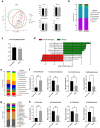Effects of Prevotella copri on insulin, gut microbiota and bile acids
- PMID: 38626129
- PMCID: PMC11028016
- DOI: 10.1080/19490976.2024.2340487
Effects of Prevotella copri on insulin, gut microbiota and bile acids
Abstract
Obesity is becoming a major global health problem in children that can cause diseases such as type 2 diabetes and metabolic disorders, which are closely related to the gut microbiota. However, the underlying mechanism remains unclear. In this study, a significant positive correlation was observed between Prevotella copri (P. copri) and obesity in children (p = 0.003). Next, the effect of P. copri on obesity was explored by using fecal microbiota transplantation (FMT) experiment. Transplantation of P. copri. increased serum levels of fasting blood glucose (p < 0.01), insulin (p < 0.01) and interleukin-1β (IL-1β) (p < 0.05) in high-fat diet (HFD)-induced obese mice, but not in normal mice. Characterization of the gut microbiota indicated that P. copri reduced the relative abundance of the Akkermansia genus in mice (p < 0.01). Further analysis on bile acids (BAs) revealed that P. copri increased the primary BAs and ursodeoxycholic acid (UDCA) in HFD-induced mice (p < 0.05). This study demonstrated for the first time that P. copri has a significant positive correlation with obesity in children, and can increase fasting blood glucose and insulin levels in HFD-fed obese mice, which are related to the abundance of Akkermansia genus and bile acids.
Keywords: Obesity; bile acids; gut microbiota; insulin; prevotella copri.
Conflict of interest statement
No potential conflict of interest was reported by the author(s).
Figures





References
-
- Abarca-Gómez L, Abdeen ZA, Hamid ZA, Abu-Rmeileh NM, Acosta-Cazares B, Acuin C, Adams RJ, Aekplakorn W, Afsana K, Aguilar-Salinas CA. Worldwide trends in body-mass index, underweight, overweight, and obesity from 1975 to 2016: a pooled analysis of 2416 population-based measurement studies in 128·9 million children, adolescents, and adults. Lancet. 2017;390(10113):2627–2642. doi:10.1016/S0140-6736(17)32129-3. - DOI - PMC - PubMed
-
- Venn AJ, Thomson RJ, Schmidt MD, Cleland VJ, Curry BA, Gennat HC, Dwyer T. Overweight and obesity from childhood to adulthood: a follow-up of participants in the 1985 Australian schools health and fitness survey. Med J Aust. 2007;186(9):458–460. doi:10.5694/j.1326-5377.2007.tb00997.x. - DOI - PubMed
Publication types
MeSH terms
Substances
Supplementary concepts
LinkOut - more resources
Full Text Sources
Medical
